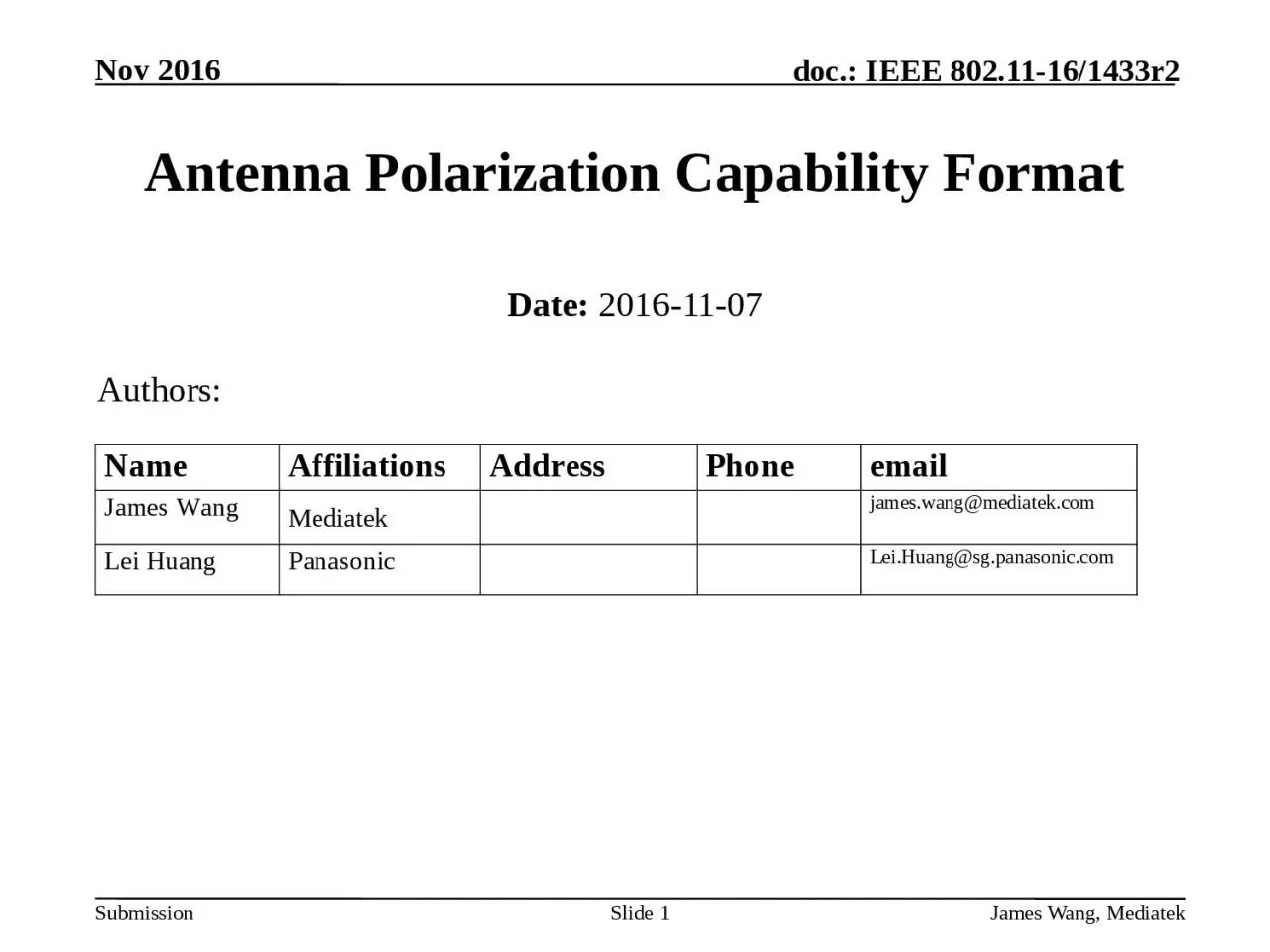

Date 20161107 Slide 1 Authors Introduction Multiple antenna polarizations is an attractive way for small devices with limited space to realize diversity and MIMO Due to propagation characteristics of ID: 914499
Download Presentation The PPT/PDF document "Antenna Polarization Capability Format" is the property of its rightful owner. Permission is granted to download and print the materials on this web site for personal, non-commercial use only, and to display it on your personal computer provided you do not modify the materials and that you retain all copyright notices contained in the materials. By downloading content from our website, you accept the terms of this agreement.
Slide1
Antenna Polarization Capability Format
Date: 2016-11-07
Slide 1
Authors:
Slide2Introduction
Multiple antenna polarizations is an attractive way for small devices with limited space to realize diversity and MIMO Due to propagation characteristics of mmWave, antenna polarization can affect the performance significantly if polarization is misaligned, it affecting end-to-end performance significantly (i.e., signal drops due to polarization misalignment, cross-polarization interference rises)
Antenna polarization can support MIMO spatial multiplexing.Intel IEEE 802.11-15/1145r0 SU-MIMO Configurations for IEEE 802.11ay illustrates multiple antenna configurations for SU-MIMO. Several of them relies on antenna polarization.
11ay should adopt more powerful and efficient method to deal with the effects of polarization for ensuring reliable performanceIEEE Motion 5/2016 “antenna polarization capability information in the 11ay capability exchange. (Capability information is TBD)” The current proposal provides the capability format
2
Slide3Basic Types of Antenna PolarizationTypes of antenna polarization
Linear polarizationCircular (elliptical) polarizationMixed polarization (difficult to classify)There are three possible orthogonal polarizations (
e.g, x, y, z directions)In general, the polarization direction is described by unit vector or
euler angle (α, β, γ) relative to a coordinate systemDepending on antenna axial ratio, orientation, and propagation, the cross-polarization alignment loss (provided in backup charts) can be significant.
3
Slide4Polarization Implementations
Two types of polarization implementationSeparate antennas for different polarizations (e.g., one antenna vertical, one antenna horizontal) Same antenna with multiple polarizations (e.g., one physical antenna with multiple polarization ports)In general, the former type can be treated as separate antennas
The latter type can also be used to synthesize different antenna polarizations:
Polarization rotation (i.e. to change angle of inclination for TX/RX polarization alignment)Linear to circular polarization conversion or vice versaThe latter type can be used for polarization MIMO, which means that >1 spatial streams are transmitted or received on dual polarizations of the same physical antenna
[
IEEE 802.11-15/1145r0 SU-MIMO Configurations for IEEE 802.11ay, Intel]
4
Inclined Linear (
θ
1
=
θ
2
G
1/G2) or Circular (θ
1=θ2
+/-90 deg, G1=G2)
⁺
G
1
G
2
θ
1
θ
2
Slide5Polarization Type/Capability
Antenna polarization capability information to be considered (Polarization Configuration)Single PolarizationPolarization SwitchSynthesizable PolarizationMIMO Dual Polarization
Each polarization configuration above can be one of the following types:Linear
Circular mixed polarization (difficult to classify as linear or circular)5
Slide6Proposed Antenna Polarization Capability FieldThe Antenna Polarization Capability field is defined
The Number of DMG Antennas subfield defines the combined total number of antennas of an EDMG STA.The number of Polarization Capability subfields are equal to the value indicated in the Number of DMG Antenna subfield.
Slide 6
Slide7Proposed Polarization Capability subfield formatThe Polarization Capability subfield is defined below
The TX/RX subfield is set to 1 to indicate the antenna is for both transmission and reception, is set to 2 to indicate the antenna is for for
transmission, and is set to 3 to indicate the antenna is for reception only. The value 0 is reserved. The Polarization Configuration subfield is set to 0 to indicate Single Polarization, is set to 1 to indicate Polarization switch, is set to 2 to indicate Synthesizable Polarization, and is set to 3 to indicate MIMO Dual Polarization.
Slide 7
B0 B1
B2 B3
B4 – B10
B11- B15
TX/RX
Polarization
Configuration
Polarization
Description
Reserved
Bits:
2
2
7
5
Slide8Polarization DescriptionIf the value of the Polarization Configuration subfield is Single Polarization,
or MIMO Dual Polarization, the Polarization Description is set to 0 to indicate linear polarization, is set to 1 to indicate circular polarization, and is set to 2 for mixed polarization. The values 3 to 127 are reserved.
If the value of the Polarization Configuration subfield is Synthesizable Polarization, the Polarization Description is set to 0 to indicate linear polarization, is set to 1 to indicate circular polarization, is set to
2 to indicate mixed polarization, and is set to 3 to indicate support of both linear and circular. The values 4 to 127 are reserved.Slide
8
B4 B10
Polarization Description
7
Slide9Polarization DescriptionIf the value of the Polarization Configuration subfield is Polarization Switch, the Polarization Description subfield contains 4 subfields.
The Number of Throws subfield is set to 0 to indicate 2 throws and is set to 1 to indicate 3 throws.Each of the Throw 1 Polarization subfield, the Throw 2 Polarization subfield, or the Throw 3 Polarization subfield is set to set to 0 to indicate linear polarization, is set to 1 to indicate circular polarization, and is set to 2 for mixed
polarization. The value 3 is reserved. If the antenna polarization switch has only 2 throws, the Throw 3 Polarization subfield is reserved.
Slide 9
B4
B5 B6
B7 B8
B9 B10
Number of Throws
Throw 1 Polarization
Throw 2 Polarization
Throw 3 Polarization
1
2
2
2
Slide10Straw PollDo you agree to add the format of Antenna Polarization Capability Field as defined in slides 6 -9 into the 11ay SFD?
Slide 10